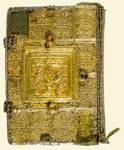|
|
| Byzantine Minor Arts |
14th and 15th c. Iviron Monastery Silver gilt, with repoussι and open-work, gemmed 21 x 14.6 x 7.5 cm |
|

|
Both sides of this interesting cover are formed of four rows of open-work rectangles, all of which have suffered some damage - especially those in the corners. Over these, in the middle of each side, has been nailed a plaque decorated in repoussι work; the ornamentation of the cover also includes cabochon gems. The spine of the book is covered with parallel vertical rows of metallic strips wound into tight spiral tubes. Of the rectangular compartments, two have been lost entirely (front: upper right and lower left), four on the front and back are largely missing, and two more on the front are damaged. Their decorative motif is a scroll of four intricately spiralling tendrils with flowers formed of petals and half petals. A similar open-work ornament, but with two spirals more tightly coiled, is found on the revetment of a fourteenth-century icon of the Virgin Hodegetria in the Monastery of Vatopedi (Loverdou-Tsigarida 1996, pp. 486-7, fig. 433). The ornamentation of this cover, with its more open arrangement of the flora motifs that does not conceal the metal between the tendrils, is closer to Byzantine filigree work and to the opus venetum, the characteristic filigree work of thirteenth- to sixteenth-century Venice. The borders of the rectangles are undecorated, to allow for the placing of the rivets, but thus combined they form a broader band with a groove down the middle. The two figurative plaques differ not only in size but in several other details as well, indicative of different ornamental conceptions. The Anastasis decorating the front is executed in repoussι work; it is the larger of the two, and the composition, which has no frame, extends right to the edges of the plaque: in fact, the figures of Eve and David are incomplete. Christ, depicted on a larger scale than the other figures, with a large halo inscribed with a cross and a small cross of the Anastasis in his left hand, has turned away from the prophet-kings to raise the kneeling Adam from his sarcophagus. The gates of Hell, fallen cross-wise under his parted feet, are barely visible. Embossed into the upper edge of the plaque is the inscription 'The Anastasis'. This iconographic type of the Anastasis, one of the earliest, is rarely found on fourteenth-century silver covers. A similar composition, however, may be seen in the late thirteenth-century icon of the Fermo Madonna (Grabar 1975, no. 17, p. 44), where it occupies the lower left-hand corner of the frame. The Crucifixion on the back of the cover has a broad border with a double groove, and a wide frame, the top element of which bears the repoussι inscription: 'The Crucifixion'. The scene, smaller in scale, with only the three principal figures represented, is austere, and the gestures of the Virgin and St John express both suffering and compassion, as in similar Crucifixion representations on other fourteenth-century silver icon revetments. There is a remarkable iconographic similarity between this scene and the Crucifixion on the icon revetment from the Monastery of Vatopedi referred to above, not only in the scheme and in the gestures of the figures, but also in such details as the row of low buildings in the background or the triangular shape of the 'place called Golgotha'. The inscriptions on the Crucifixion of the Gospel cover, however, are incised on repoussι plaquettes, as they are in Vatopedi icon revetments (Loverdou-Tsigarida 1996, fig. 438). On the basis of these features, then, the flora panels may be ascribed to the fifteenth century, while the two narrative compartments, products of different workshops, to the early fourteenth century.
| |
|
Bibliography: Unpublished.
| ||
| K. L-T. | ||
| Index of exhibits of Monastery of Iviron 14th century |
||
Reference address : https://www.elpenor.org/athos/en/e218ci20.asp